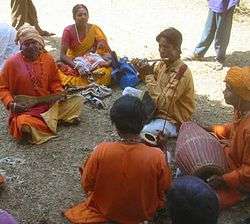Intangible cultural heritage

Intangible cultural heritage (ICH) is promoted by UNESCO as a counterpart to the World Heritage focusing mainly on intangible aspects of culture. In 2001, UNESCO made a survey[1] among States and NGOs to try to agree on a definition, and the Convention for the Safeguarding of Intangible Cultural Heritage[2] was drafted in 2003 for its protection and promotion.
Definition
The Convention for the Safeguarding of the Intangible Cultural Heritage[3] defines the intangible cultural heritage as the practices, representations, expressions, as well as the knowledge and skills (including instruments, objects, artifacts, cultural spaces), that communities, groups and, in some cases, individuals recognise as part of their cultural heritage. It is sometimes called living cultural heritage, and is manifested inter alia in the following domains:[4]
- Oral traditions and expressions, including language as a vehicle of the intangible cultural heritage;
- Performing arts;
- Social practices, rituals and festive events;
- Knowledge and practices concerning nature and the universe;
- Traditional craftsmanship

Cultural heritage in general consists of the products and processes of a culture that are preserved and passed on through the generations. Some of that heritage takes the form of cultural property, formed by tangible artefacts such as buildings or works of art. Many parts of culture, however are intangible, including song, music, dance, drama, skills, cuisine, crafts and festivals. They are forms of culture that can be recorded but cannot be touched or stored in physical form, like in a museum, but only experienced through a vehicle giving expression to it. These cultural vehicles are called "Human Treasures" by the UN.
According to the 2003 Convention for the Safeguarding of the Intangible Cultural Heritage, the intangible cultural heritage (ICH) – or living heritage – is the mainspring of humanity's cultural diversity and its maintenance a guarantee for continuing creativity. It is defined as follows:
Intangible Cultural Heritage means the practices, representations, expressions, knowledge, skills – as well as the instruments, objects, artifacts and cultural spaces associated therewith – that communities, groups and, in some cases, individuals recognize as part of their cultural heritage. This intangible cultural heritage, transmitted from generation to generation, is constantly recreated by communities and groups in response to their environment, their interaction with nature and their history, and provides them with a sense of identity and continuity, thus promoting respect for cultural diversity and human creativity. For the purposes of this Convention, consideration will be given solely to such intangible cultural heritage as is compatible with existing international human rights instruments, as well as with the requirements of mutual respect among communities, groups and individuals, and of sustainable development.
Oral history
Intangible cultural heritage is slightly different from the discipline of oral history, the recording, preservation and interpretation of historical information (specifically, oral tradition), based on the personal experiences and opinions of the speaker. ICH attempts to preserve cultural heritage 'with' the people or community by protecting the processes that allow traditions and shared knowledge to be passed on while oral history seeks to collect and preserve historical information obtained from individuals and groups.
Food heritage
With sustainable development gaining momentum as a priority of UNESCO heritage policies, an increasing number of food-related nominations are being submitted for inscription on the lists of the Convention for the safeguarding of the intangible cultural heritage.[6] The Mediterranean diet,[7] the traditional Mexican cuisine and the Japanese dietary culture of washoku are just some examples of this booming phenomenon.
Digital heritage
Digital heritage is a representation of heritage in the digital realm.
Digital intangible heritage
Digital intangible heritage is a sub-category of Intangible Cultural Heritage.[8]
Oral continuity
Intangible cultural heritage is passed orally within a community, and while there may be individuals who are known tradition bearers, ICH is often broader than one individual's own skills or knowledge. A 2006 report by the government of Newfoundland and Labrador said, regarding oral culture in their area, "The processes involved in the continuation of this traditional knowledge constitute one of the most interesting aspects of our living heritage. Each member of the community possesses a piece of the shared knowledge.[9] Crucial knowledge is passed on during community activities, frequently without any conscious attention to the process.[10]
Preservation
Prior to the UNESCO Convention, efforts had already been made by a number of states to safeguard their intangible heritage.[11] Japan, with its 1950 Law for the Protection of Cultural Properties, was the first to introduce legislation to preserve and promote intangible as well as tangible culture: Important Intangible Cultural Properties are designated and "holders" recognized of these craft and performance traditions, known informally as Living National Treasures.[5][12] Other countries, including South Korea (Important Intangible Cultural Properties of Korea), the Philippines, the United States, Thailand, France, Romania, the Czech Republic, and Poland, have since created similar programs.[12]
In 2003 UNESCO adopted the Convention for the Safeguarding of the Intangible Cultural Heritage. This went into effect on April 20, 2006. The Convention recommends that countries and scholars develop inventories of ICH in their territory, as well as work with the groups who maintain these ICH to ensure their continued existences; it also provides for funds to be voluntarily collected among UNESCO members and then disbursed to support the maintenance of recognized ICH.[12] UNESCO has also created other intangible culture programs, such as a list called Proclamation of Masterpieces of the Oral and Intangible Heritage of Humanity. This list began in 2001 with 19 items and a further 28 were listed in 2003 and another 43 in 2005. In part, the original list was seen as a way to correct the imbalance in the World Heritage List, since it excluded many Southern Hemisphere cultures which did not produce monuments or other physical cultural manifestations.[12] It was superseded in 2008 by the UNESCO Intangible Cultural Heritage Lists.
Recently there has been much debate over protecting intangible cultural heritage through intellectual property rights, as well as the desirability to do so through this legal framework and the risks of commodification derived from this possibility.[13] The issue still remains open in legal scholarship.
By country
| Rank | Country | Number of Intangible Cultural Heritage elements inscribed by UNESCO[14][15] |
|---|---|---|
| 1 | 38[16] | |
| 2 | 22[17] | |
| 3 | 19[18] | |
| 4 | 14[19] | |
| 4 | 14[20] | |
| 6 | 13[21] | |
| 7 | 12[22] | |
| 7 | 12[23] | |
| 7 | 12[24] | |
| 10 | 11[25] |
Gallery
-

Baul singers at Vasantotsav, Shantiniketan
-

A Kunqu performer's portrayal of Hu Sanniang
-
Albanian polyphonic folk group wearing qeleshe and fustanella in Skrapar
-
Estonian Song Festival, one of the largest amateur choral events in the world
See also
- Cultural heritage
- Czech folklore
- Intangible Cultural Heritage in Finland
- Living human treasure
- Non-material culture
- Oral history
- Oral tradition
- UNESCO Intangible Cultural Heritage Lists
References
- ↑ "Meeting of 2001". UNESCO. Retrieved 2007-06-20.
- ↑ "Official website". UNESCO. Retrieved 2007-06-20.
- ↑ "UNESCO".
- ↑ LOMITKO (1 October 2005). "Definition of Intangible Heritage".
- 1 2 Yang Jongsung (2003). Cultural Protection Policy in Korea: Intangible Cultural Properties and Living National Treasures. Jimoondang International. pp. 33ff. ISBN 1931897050.
- ↑ "At the UNESCO feast: introduction".
- ↑ SILVA, A. J. M. (2016). Create Space, ed. Le régime UNESCO (Discours et pratiques alimentaires en Méditerranée vol. III) (in French). Charleston. ISBN 1532997116.
- ↑ Khan, Muqeem (1 March 2015). "Transmitting Al Ardha: Traditional Arab Sword Dance". International Journal of Heritage in the Digital Era. 4 (1): 71–86. doi:10.1260/2047-4970.4.1.71 – via multi-science.atypon.com (Atypon).
- ↑ Farah, Paolo Davide; Tremolada, Riccardo (March 15, 2014). "Desirability of Commodification of Intangible Cultural Heritage: The Unsatisfying Role of Intellectual Property Rights". Transnational Dispute Management. 11 (2). Retrieved 3 November 2015.
- ↑ "Creative Newfoundland and Labrador: The Blueprint for Development and Investment in Culture" Government of Newfoundland and Labrador, 2006, page 34.
- ↑ Deacon, Harriet (et al.) (2004). "The Subtle Power of Intangible Heritage: Legal and Financial Instruments for Safeguarding Intangible Heritage" (PDF). Human Sciences Research Council. p. 21. ISBN 0796920745.
- 1 2 3 4 Kurin, Richard (1 May 2004). "Safeguarding Intangible Cultural Heritage in the 2003 UNESCO Convention: a critical appraisal". Museum International. 56 (1-2): 66–77. doi:10.1111/j.1350-0775.2004.00459.x.
- ↑ Farah, Paolo Davide and Tremolada, Riccardo Conflict between Intellectual Property Rights and Human Rights: A Case Study on Intangible Cultural Heritage (December 19, 2015). Oregon Law Review, Vol. 94, No. 1, 2015
- ↑ "Map of the Intangible Cultural Heritage". UNESCO.
- ↑ "Statistics of the Intangible Cultural Heritage". UNESCO.
- ↑ "China - Intangible Cultural Heritage".
- ↑ "Japan - Intangible Cultural Heritage".
- ↑ "Republic of Korea - Intangible Cultural Heritage".
- ↑ "Spain - Intangible Cultural Heritage".
- ↑ "Croatia - Intangible Cultural Heritage".
- ↑ "France - Intangible Cultural Heritage".
- ↑ "Belgium - Intangible Cultural Heritage".
- ↑ "Mongolia - Intangible Cultural Heritage".
- ↑ "Turkey - Intangible Cultural Heritage".
- ↑ "India - Intangible Cultural Heritage".
External links
| Wikivoyage has a travel guide for UNESCO Intangible Cultural Heritage. |
- Official website
- Definitions of Intangible Cultural Heritage as of States, IGOs and NGOs in 2001
- Full text of the Convention
- What Is ICH? document from Newfoundland, Canada
- Exploring a Model of Living Cultural Heritage New model of Intangible heritage
